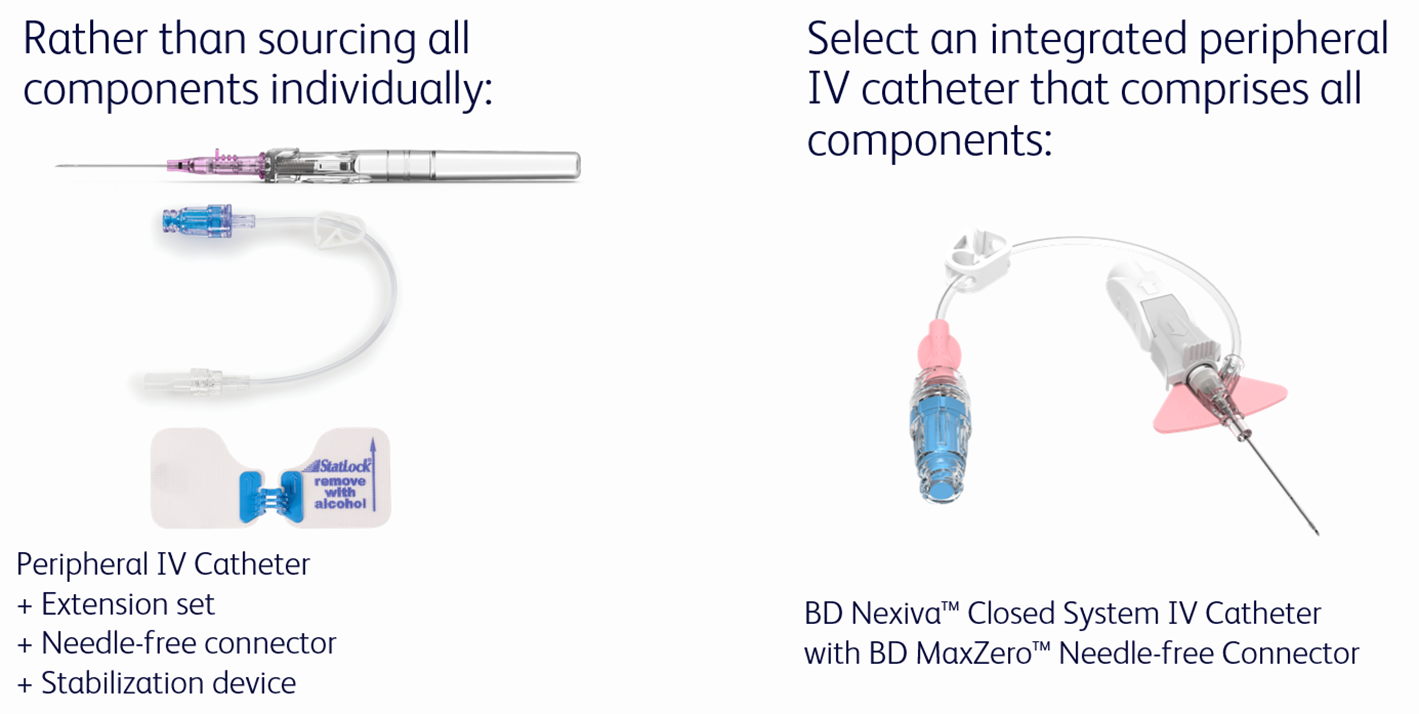Is there more to the picture when it comes to Peripheral IV catheter costs?


Potential complications consist of phlebitis, occlusion, dislodgement, and infection. Any of these complications, either alone or in combination, can lead to catheter removal before the end of the intended dwell time1. Reducing PIVC complications can lead to a longer dwell time (i.e. the catheter remains operational for longer) and minimize the need for painful restarts4,5. This could reduce the volume of devices required by your organization and potentially save costs.
Additionally, any patient complications need to be addressed, and their management can be costly as well. For example, bloodstream infections can cost an organization from $33,000 to $75,000 USD for a patient in the ICU6. Selecting an IV catheter that can reduce the risk of complications could help you to reduce the economic burden of complications in your organization.

Occupational Health and Safety
Not all Peripheral IV Catheters are created equal – devices without blood control are still in use today.
- When healthcare workers use a PIVC without a blood control feature, blood leakage may occur during insertion up to 61% of the time7
- Blood leakage exposes HCWs to more than 30 dangerous bloodborne pathogens (BBPs), including hepatitis B, C, and HIV8
- Blood exposure is an economic burden on healthcare organizations. Post exposure management costs could be up to $4,838 USD per reported exposure9
- The cost of blood cleanup may be as high as $0.30 USD per insertion with blood leakage10,+

Procurement
Your time is precious. Managing supply can be challenging as there are many product categories and many external factors impacting the supply chain. Choosing an integrated peripheral IV catheter could streamline your ordering and cart space. There may also be cost savings to explore.

Interested in learning more?
The cost of peripheral IV catheters (PIVCs) on your healthcare organization goes beyond the price of the device
Selecting an IV catheter that can reduce the risk of complications could help you to reduce the economic burden of complications in your organization.
Learn how BD Nexiva™ can make your IV practice safer for yourself and your patients
Discover the difference of a closed PIVC system.
How prevalent are Peripheral IV Catheter complications?
Peripheral IV Catheter (PIVC) complications cause multiple restarts that affect everyone and everything, in almost every department. Additionally, IV catheters without blood control are still in use today.


Discover how the BD Nexiva™ Closed IV Catheter System can help you to save costs by reducing complications, increasing healthcare worker safety, and realizing procurement efficiencies.
Opt-in below to get connected with a BD sales representative and/or to learn more about how BD Nexiva™ could reduce costs:
REFERENCES
+ Cost per cleanup for the gauze, absorbent drapes, towels, and sheets used per event
*Compared to an open system
**Compared to a non-blood control catheter
1. Helm RE, Klausner JD, Klemperer JD, et al. Accepted but unacceptable: peripheral IV catheter failure. Infus Nurs Society. 2015;38(3):189-203.
2. Paice T. Economic impact of an extravasation: an analysis. Imaging Economics. 2007;20(3):14. 10. Roszell S, Jones C. Intravenous administration issues. J Infus Nurs. 2010;33(2):112-118.
3. Hambridge K, Nichols A, Endacott R. The impact of sharps injuries on student nurses: a systematic review. British journal of nursing (Mark Allen Publishing). 2016;25(19):1064-1071.
4. Bausone-Gazda D, Lefaiver CA, Walters SA. A randomized controlled trial to compare the complications of 2 peripheral intravenous catheter stabilization systems. J Infus Nurs. 2010;33(6):371-384.
5. González López J, Arribi Vilela A, Fernández Del Palacio E, et al. Indwell times, complications and costs of open vs closed safety peripheral intravenous catheters: a randomized study. J Hosp Infect. 2014;86(2):117-126.
6. Hollenbeak CS. The cost of catheter-related bloodstream infections. J Infus Nurs. 2011;34(5):309-313.
7. Haeseler G, Hildebrand M, Fritscher J. Efficacy and ease of use of an intravenous catheter designed to prevent blood leakage: A prospective observational study. J Vasc Access. 2015;16(3):233-236.
8. European Biosafety Network. Prevention of Sharps Injuries in the Hospital and Healthcare Sector. European Biosafety Network. Implementation Guidance Toolkit for EU Council Directive 2010/32/EU. January 2013 Available at: www.europeansafetynetwork.eu (accessed May 2017).
9. O’Malley EM, Scott RD2nd, Gayle J, et al. Costs of management of occupational exposures to blood and body fluids. Infect Control Hosp Epidemiol. 2007;28(7):774-782.
10. Richardson D, Kaufman L. Reducing blood exposure risks and costs associated with SPIVC insertion. Nurs Manage. 2011;42(12):31-34.
11. Onia R, Eshun-Wilson I, Arce C, Ellis C, Parvu V, Hassman D, Kassler-Taub K. Evaluation of a new safety peripheral IV catheter designed to reduce mucocutaneous blood exposure. Current medical research and opinion. 2011 Jul 1;27(7):1339-46.
BD is committed to keeping your personal data protected and secure. More information on how we protect your personal data can be found in our privacy statement and our cookie policy.



